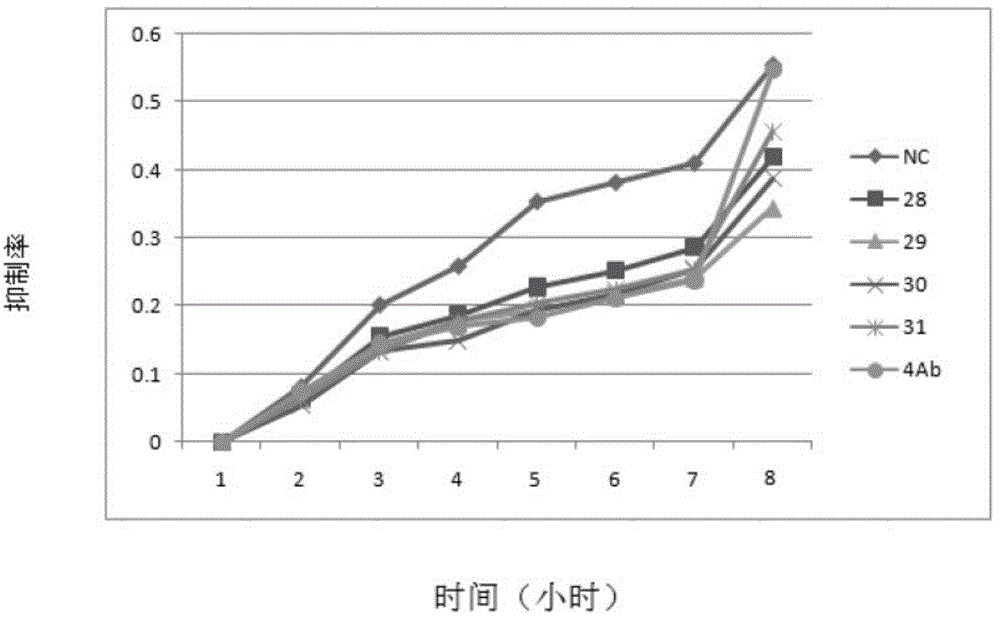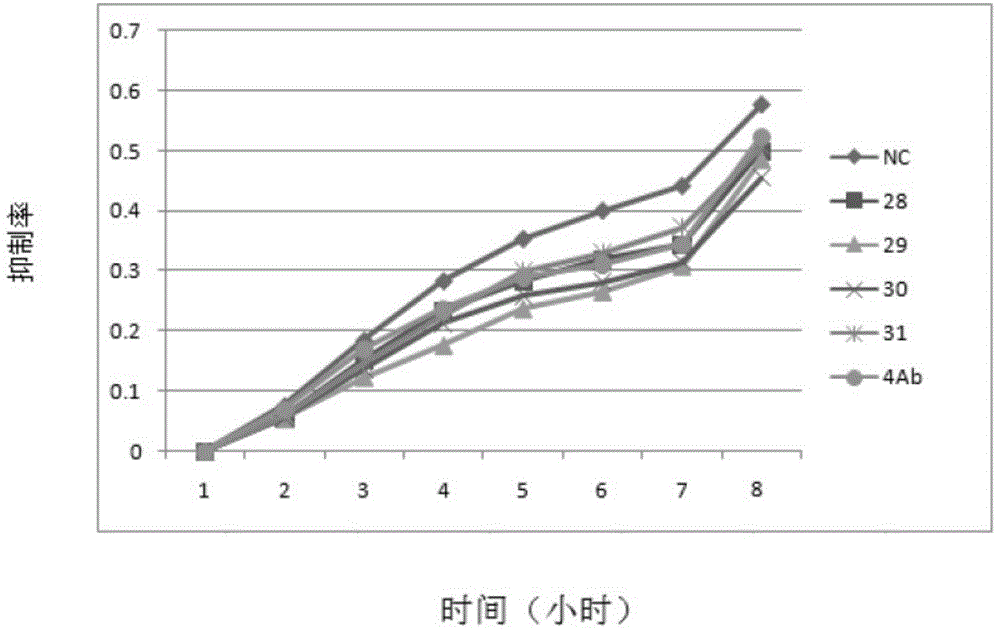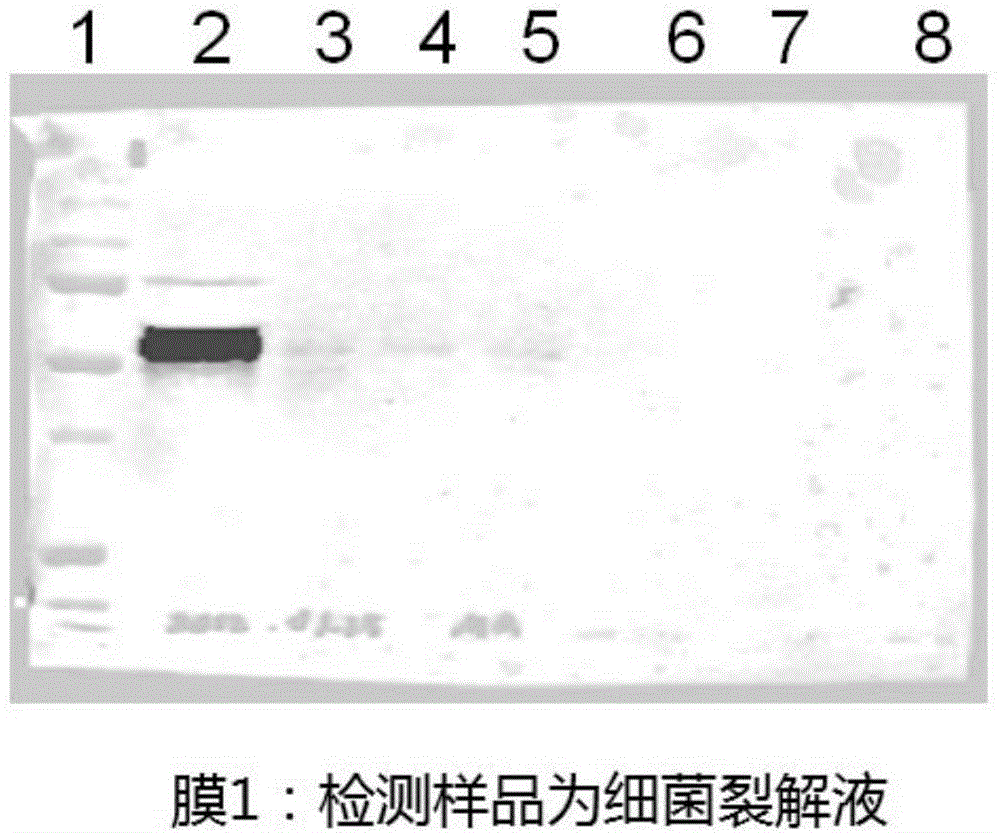Enzyme-linked immunoassay kit for detecting methicillin-resistant staphylococcus aureus
An enzyme-linked immunosorbent reagent and methicillin-resistant technology, applied in antibacterial immunoglobulins, measuring devices, antibacterial drugs, etc., can solve the problems of false positives, false negatives, complicated processing operations, etc., and achieve simple operation and sensitivity. The effect of high and good application prospects
- Summary
- Abstract
- Description
- Claims
- Application Information
AI Technical Summary
Problems solved by technology
Method used
Image
Examples
Embodiment 1
[0027] Example 1: Preparation of PBP2α protein.
[0028] (1) Cloning of mecA target gene
[0029] The amino acid sequence ID number of PBP2α protein is EUE27353.
[0030] The mecA gene encodes PBP2α protein, and its gene sequence is derived from JBDL01000002 (http: / / www.ncbi.nlm.nih.gov / protein / EUE27353).
[0031] According to the mecA gene sequence, two primers were designed as follows:
[0032] ATCTTCACCAACACCTAGTT;
[0033] ATGAAAAAGATAAAAATTGT.
[0034] The expression mecA target gene was obtained by PCR amplification, and the vector pET-28a and the mecA gene fragment purified by agarose gel were subjected to double enzyme digestion with NcoI+XhoI, and the purified enzyme digestion product was ligated with T4DNA ligase to obtain Recombined plasmid pET-28a-PBP2α, and the ligated product was transformed into Escherichia coli DH5α, clones were selected on LB plates containing ampicillin, plasmids were prepared in small quantities, positive clones were screened out by doub...
Embodiment 2
[0040] Embodiment 2: the preparation of monoclonal antibody
[0041] 1) Establishment of mouse anti-PBP2α hybridoma cell line and identification of monoclonal antibody subtypes
[0042] a. The immunization program adopts 4 basic immunizations and 1 booster immunization. Select 2 healthy female BalB / c mice aged 6-8 weeks, weighing about 18g, and feed them for 1 week, and collect negative blood as a control;
[0043] b. Adopt a medium-range immunization program (0.3mL / monkey, 2 weeks / time), at the first immunization (50μg / mouse), stir and emulsify the immunogen with an equal volume of Freund's complete adjuvant, inject it subcutaneously at multiple points on the back, and then press Stir and emulsify the immunogen with an equal volume of Freund's incomplete adjuvant for routine immunization;
[0044] c. For the third immunization, generally 50 μg of antigen + TiterMax is mixed and emulsified in equal amounts and injected at multiple points on the back, and the titer is measure...
Embodiment 3
[0055] Example 3: Screening of anti-PBP2α antibodies and determination of epitopes
[0056] (1) In this example, the culture supernatant of MRSA bacteria was used as the coating antigen, and the 5 strains of monoclonal antibodies prepared in Example 2 were used as the detection antibodies to be coupled with biotin to establish an indirect ELISA method for detecting PBP2α .
[0057] a) Coating of the microtiter plate
[0058] Coating solution (Na 2 CO 3 1.5g, NaHCO 3 2.9g, Na 2 N 3 1.2g, add ddH 2 (0 to 1 L, adjust the pH to 9.6) Mix the antigen evenly and add it to a 96-well ELISA plate, 100 μl per well, and seal the plate at 4°C overnight.
[0059] b) Sealing of the microtiter plate
[0060] PBS containing 5% skim milk was used as blocking solution. First, pat dry the ELISA plate coated overnight, add 200 μl / well blocking solution, block at 37°C for 2 hours, wash the plate 6 times with a plate washer, pat dry the ELISA plate, and store it at 4°C for later use, or -20...
PUM
 Login to View More
Login to View More Abstract
Description
Claims
Application Information
 Login to View More
Login to View More - R&D
- Intellectual Property
- Life Sciences
- Materials
- Tech Scout
- Unparalleled Data Quality
- Higher Quality Content
- 60% Fewer Hallucinations
Browse by: Latest US Patents, China's latest patents, Technical Efficacy Thesaurus, Application Domain, Technology Topic, Popular Technical Reports.
© 2025 PatSnap. All rights reserved.Legal|Privacy policy|Modern Slavery Act Transparency Statement|Sitemap|About US| Contact US: help@patsnap.com



